Global Cooling 1940 – 1975 explained for climate change experts
 Post 18 Februray 2017; Continued from: dr-judith-curry-on-climate-sciences-fatal-flaw/ & warm-up-1918-1939-explained-for-dr-judith-curry-and-other/
Post 18 Februray 2017; Continued from: dr-judith-curry-on-climate-sciences-fatal-flaw/ & warm-up-1918-1939-explained-for-dr-judith-curry-and-other/
In the previous post we lauded Dr. Judith Curry for her recent statement: “If science can’t explain climate shifts pre 1950, how can we trust today’s climate models?” One of these two shifts was the warming from 1918-1939, we covered: HERE; while the very significant global cooling period from winter 1939/40 to mid-1970s is our topic today, as it is either a widely unexplored field. In our view: the models fail because this cooling was man-made due to naval war during World War Second (WWII), at least according the work of Dr. Arnd Bernaerts (Book 2004

and Book 2012). With reference to them, we will try to explain a prima facie connection between these events, and how easy man can interfere with nature and initiate a pronounced climatic change.
Actually, not the impact of two brief naval wars on climate should be a top scientific agenda, but propeller driven motor ships. Many hundred-thousand ships transverse the oceans, up to 500 miles and more every day. During the last 170 years any ship at sea mixes the surface layer down to 20 meters and more, usually forcing more heat into the sea body than forcing colder water toward the surface. Much of the warming of global air temperature since about 1850 might have been caused in this way. Any proof in this respect is currently unavailable, as science is not aware of this point, even worse, incapable to recognize the oceans as principle driver of climate.
This scientific gap could be sufficiently eliminated by analyzing two short time periods of naval warfare during the two World Wars, while recognizing the different mechanisms that caused warming from 1918 to winter 1993/40 (HERE), and the global cooling thereon until about 1975. While the former period could be localized to an area from Great Britain to the Atlantic section in the Arctic Ocean, the caus

es of the latter period cover the entire North Atlantic (1939-1945) and the Pacific west of Hawaii (1941-1945), both with a very complex temperature, salinity and current structure, great depths, and temperatures of merely about 4°C. In this delicate marine environment, many ten-thousand war ships plugged the sea, and may billion objects exploded and sank to the bottom of the sea, over several dozen meters or thousand kilometers. Impossible that the sea structure (temperature and salinity) was not severely affected, and the ‘natural sea current profile’ not so heavily altered and diverted that it took at least one generation to erase the war impact, which lasted until about the 1970s. The attached temperature maps hardly allow another conclusion. As science has done nothing for proving anything in this respect, the impact of naval warfare on weather can be proven during the three extreme war winters in Europe 1939/40, 1940/41 and 1941/42, which came unexpected, and were in wide regions the coldest periods for more than 100 years.
With some interest and effort the three war winter can be sufficiently connected to human activities in the North Sea and Baltic since September 1939, due to the fact that these seas are fairly shallow (90m/55m), storing heat during the summer and releasing it in winter. It works like spoon stirring hot coffee, attracting cold air from Siberia (More HERE). In this respect they serve as confined research regions, like a unique field laboratory experiment. Each of the three winters produced its own finger-print, of which the most prominent are mentioned.
Winter 1939/40: From 1st September 1039 on the Southern North and Baltic Sea were covered by unprecedented activities from navigation, shelling, bombing, sea mines and so on. Very soon temperature fell from Brussels to Kaliningrad to levels not seen for several generations, and sea ice cover for many dozen years. In Berlin January and February temperature were second to the coldest ever recorded after 1709.
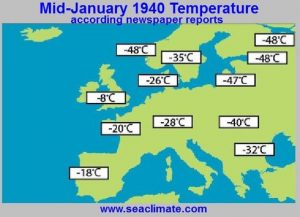 |
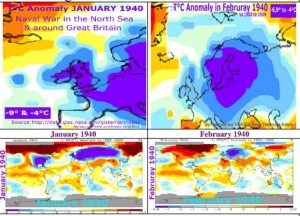 |
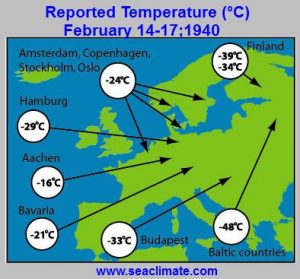 |
Fig. 4; Mid-January 1940 |
Fig. 5; Jan/Feb 1940 |
Fig. 6; Mid_February 1940 |
Winter 1940/4: During 1940 military activities concentrated from Narvik to Brest, and since April while occupying Norway, particularly affecting the Skagerrak aera. Subsequently the winter ‘cold pole’ covered Southern Norway, Western Sweden and Northern Denmark.
Winter 1941/42 is a particular illustrative case. The ambush on Russia since June 1941, included intensive naval warfare in the Eastern Baltic over seven months until sea ice prevented further activities. The Baltic region was thrown back to Little Ice Age condition, for example into the coldest winter in Stockholm since 1756, and unbelievable condition in Tallinn – see Fig. 9.
 |
 |
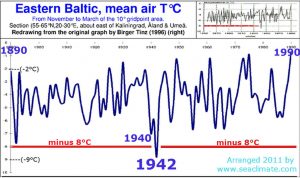 |
Fig. 7; Winter Denmark |
Fig. 8; Winter Stockholm |
Fig. 9; Winter Tallinn |

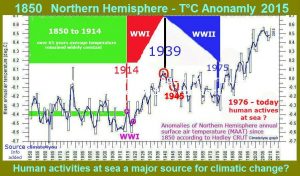
I find all your articles and boks very interesting. Thank you for sharing your work with us!
Thanks for these edifying articles. I reblogged this with this summary:
The Oceans Govern Climate. Man influences the ocean governor by means of an expanding fleet of motorized propeller-driven ships. Naval warfare in the two World Wars provide the most dramatic examples of the climate effects.
Neither I nor Dr. Bernaerts claim that shipping and naval activity are the only factors driving climate fluctuations. But it is disturbing that so much attention and money is spent on a bit player CO2, when a much more plausible human influence on climate is ignored and not investigated.
https://rclutz.wordpress.com/2017/02/18/ocean-climate-ripples/
A very fine summary, Thanks a lot! Indeed climate impact by activities at sea can range between 90 % and few digit, but even a low number is not “natural variability” but man made, as too often mentioned if science has no idea what to say about the cause.